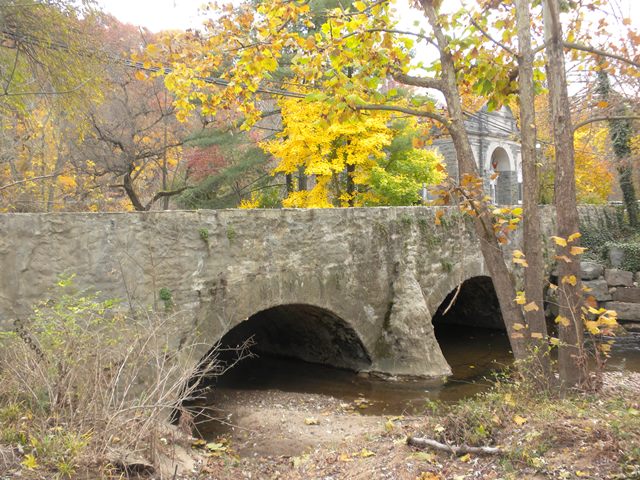We Recommend:
Bach Steel - Experts at historic truss bridge restoration.
BridgeHunter.com Phase 1 is released to the public! - Visit Now
Parkton Stone Arch Bridge
Frederick Road Bridge

Primary Photographer(s): Bob Dover
Bridge Documented: November 2, 2013
Parkton: Baltimore County, Maryland: United States
1809 By Builder/Contractor: John Small, George Small,Michael Gardner, and Jonathan Jessup and Engineer/Design: John Davis
Not Available or Not Applicable
18.0 Feet (5.5 Meters)
62.0 Feet (18.9 Meters)
27 Feet (8.23 Meters)
2 Main Span(s)
100000030105010

View Information About HSR Ratings
Bridge Documentation
View Archived National Bridge Inventory Report - Has Additional Details and Evaluation
View The Historic Bridge Inventory Report For This Bridge
Information About Bridge Contributed By Bob Dover
Date:
1809
Location:
Parkton, Baltimore County, Maryland. A few
miles east of Interstate 83, about 35 miles north of Baltimore and 7 miles south
of the Maryland/Pennsylvania state line. The bridge is located where Old York
Road crossed Little Falls in the center of Parkton.
Setting:
Rural,
in woods just outside boundary of Gunpowder Falls State Park, next to a few
houses.
Current Status:
The bridge still carries traffic, but the
amount of traffic is very limited. In the mid-1800s, the Northern Central
Railroad (NCRR) between Baltimore and York was built, and passed directly
through the center of Parkton a few hundred feet west of the bridge. The bridge
and the center of Parkton were then bypassed in 1929 with a newer, higher bridge
carrying York Road (Maryland Route 45) over the creek a few hundred feet
downstream of the Stone Arch. In the 1970s, the NCRR was closed. In the early
1990s, the railroad right-of-way was incorporated into Gunpowder Falls State
Park, and was turned into a bicycle rail trail (once called the NCRR Trail, now
called the Torrey C. Brown Trail). Old York Road was closed on either side of
the rail trail, leaving the bridge on a short dead end road, about a quarter
mile long, between York Road and the rail trail. There are two houses and a
small parking lot (space for about 10 cars) for the rail trail on this dead end
stretch between the bridge and the trail. So although the bridge does not carry
through-traffic, it does carry cars to the two houses and the parking lot. One
of the two houses is very interesting � it is in a 100-plus year old stone bank
building, right at the end of the bridge.
Crosses:
There is some
incorrect information about the name of the stream. It is a small branch of
Gunpowder Falls called Little Falls. However, the "Historic Bridges of Maryland"
by Dixie Legler and Carol M. Highsmith reports it to be "Little Gunpowder
Falls". This is not correct, as Little Gunpowder Falls is a different stream
several miles away.
Access:
Middletown Road exit from I-83. Parking
available in small lot for the rail trail a short walk from the bridge.
Construction/Description:
The bridge is a small stone arch bridge, consisting
of two arches. The length of the bridge is about 50 feet, the deck is only about
10 feet above creek level, and the bridge is only about 15 feet wide (one lane
of traffic). The bridge is made of mostly unshaped local stone, although the
arches are outlined with flat stones placed radially around the arch.
Decorations/Plaques:
The Parkton Stone Arch is listed in some documents as
the oldest bridge in the state of Maryland, dating from 1809. Interestingly, the
bridge has no date plaque or historical marker associated with it, even though
many other historical bridges in Maryland do. This is a shame, since the bridge
is visible from the rail trail which is used by hundreds of people, and is just
a few hundred feet away. The bridge also has no decorative elements, other than
the outline of the arch using stone of different orientation.
Threats:
None known. Traffic has been bypassed around the bridge on a newer road and
different bridge since the 1920s, so it is unlikely that the bridge will ever
need to be replaced to support traffic load. Even though there is no
documentation at the bridge itself, the status of the bridge as the oldest
bridge in the state is well-documented in several state publications. Therefore,
there is little risk of the bridge being removed accidentally without an
understanding of its significance.
HistoricBridges.org Discussion
Engineer is assumed, per Historic Bridge Inventory. Also assumed to be the oldest stone arch bridge in the state. The bridge appears to have been altered with gunnite, shotcrete, or excessive mortar by previous repairs. This has visually obscured the stone to some extent. The bridge is highly significant in the state context as the oldest bridge of its kind and perhaps of any kind in the state. It is also noteworthy since it was built for the Baltimore and York-town Turnpike.
![]()
Photo Galleries and Videos: Parkton Stone Arch Bridge
Bridge Photo-Documentation
Original / Full Size PhotosA collection of overview and detail photos. This gallery offers photos in the highest available resolution and file size in a touch-friendly popup viewer.
Alternatively, Browse Without Using Viewer
![]()
Bridge Photo-Documentation
Mobile Optimized PhotosA collection of overview and detail photos. This gallery features data-friendly, fast-loading photos in a touch-friendly popup viewer.
Alternatively, Browse Without Using Viewer
![]()
Maps and Links: Parkton Stone Arch Bridge
Coordinates (Latitude, Longitude):
Search For Additional Bridge Listings:
Bridgehunter.com: View listed bridges within 0.5 miles (0.8 kilometers) of this bridge.
Bridgehunter.com: View listed bridges within 10 miles (16 kilometers) of this bridge.
Additional Maps:
Google Streetview (If Available)
GeoHack (Additional Links and Coordinates)
Apple Maps (Via DuckDuckGo Search)
Apple Maps (Apple devices only)
Android: Open Location In Your Map or GPS App
Flickr Gallery (Find Nearby Photos)
Wikimedia Commons (Find Nearby Photos)
Directions Via Sygic For Android
Directions Via Sygic For iOS and Android Dolphin Browser
USGS National Map (United States Only)
Historical USGS Topo Maps (United States Only)
Historic Aerials (United States Only)
CalTopo Maps (United States Only)

